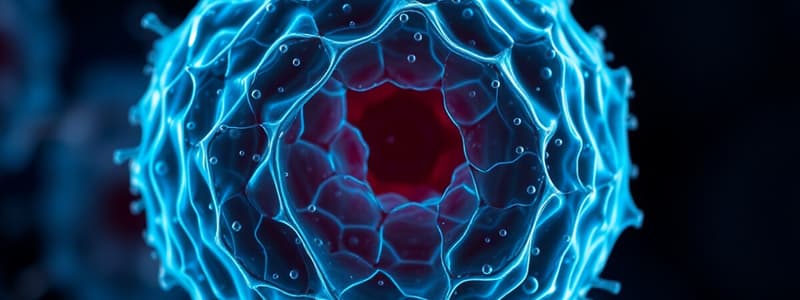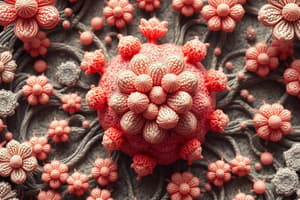Podcast
Questions and Answers
What does cellular adaptation primarily involve?
What does cellular adaptation primarily involve?
- Irreversible changes in cell function
- Strictly genetic alterations
- Permanent cell death
- Changes in the number, size, or function of cells (correct)
Which type of cellular adaptation involves an increase in cell size?
Which type of cellular adaptation involves an increase in cell size?
- Atrophy
- Hyperplasia
- Metaplasia
- Hypertrophy (correct)
Physiologic hypertrophy is a response to which of the following?
Physiologic hypertrophy is a response to which of the following?
- Genetic mutations
- Injury or damage
- Increased functional demand (correct)
- Decreased functional demand
What type of epithelium replaces columnar epithelium in the respiratory tract due to smoking?
What type of epithelium replaces columnar epithelium in the respiratory tract due to smoking?
Which cellular adaptation involves the replacement of one cell type by another?
Which cellular adaptation involves the replacement of one cell type by another?
What is the main mechanism behind hypertrophy?
What is the main mechanism behind hypertrophy?
Which condition results in the change of squamous epithelium to columnar epithelium?
Which condition results in the change of squamous epithelium to columnar epithelium?
Which of the following is NOT a type of cellular adaptation?
Which of the following is NOT a type of cellular adaptation?
What is the main cause of cell injury due to a deficiency of oxygen?
What is the main cause of cell injury due to a deficiency of oxygen?
In which scenario would you expect to see hypertrophy?
In which scenario would you expect to see hypertrophy?
Which of the following defines reversible cell injury?
Which of the following defines reversible cell injury?
What characterizes pathological adaptations?
What characterizes pathological adaptations?
What type of cellular adaptation involves an increase in the number of cells?
What type of cellular adaptation involves an increase in the number of cells?
Which factor does NOT contribute to cell injury?
Which factor does NOT contribute to cell injury?
What is the consequence of irreversible cell injury?
What is the consequence of irreversible cell injury?
Which of the following correctly describes metaplasia?
Which of the following correctly describes metaplasia?
What primarily causes atrophy in cells?
What primarily causes atrophy in cells?
Which type of atrophy occurs due to loss of nerve stimulation?
Which type of atrophy occurs due to loss of nerve stimulation?
What is a common physiological example of atrophy?
What is a common physiological example of atrophy?
What type of metaplasia is characterized by the replacement of columnar cells with squamous cells?
What type of metaplasia is characterized by the replacement of columnar cells with squamous cells?
Which mechanism typically leads to metaplasia?
Which mechanism typically leads to metaplasia?
What is a potential outcome of chronic acid reflux?
What is a potential outcome of chronic acid reflux?
Which of the following is a type of pathologic atrophy?
Which of the following is a type of pathologic atrophy?
What may cause osseous metaplasia?
What may cause osseous metaplasia?
What is hypertrophy primarily characterized by?
What is hypertrophy primarily characterized by?
Which type of hyperplasia occurs after damage or partial resection of an organ?
Which type of hyperplasia occurs after damage or partial resection of an organ?
What causes pathologic hyperplasia?
What causes pathologic hyperplasia?
What is a common example of physiological hyperplasia?
What is a common example of physiological hyperplasia?
Which condition is associated with pathological hypertrophy of cardiac muscle cells?
Which condition is associated with pathological hypertrophy of cardiac muscle cells?
What does atrophy refer to?
What does atrophy refer to?
Which is NOT a characteristic of hyperplasia?
Which is NOT a characteristic of hyperplasia?
What happens to the uterus during pregnancy in terms of hypertrophy and hyperplasia?
What happens to the uterus during pregnancy in terms of hypertrophy and hyperplasia?
Flashcards are hidden until you start studying
Study Notes
Cellular Adaptations
- Adaptations are reversible changes in cells due to environmental changes.
- Adaptations can be physiologic (normal stimulation) or pathologic (stress response).
Types of Cellular Adaptations
- Hypertrophy: Increase in cell size, leading to increased organ size.
- Caused by increased functional demand, e.g., skeletal muscle growth in bodybuilders.
- Occurs in cells incapable of division, e.g., cardiac and skeletal muscle, nerve cells.
- Can occur alongside hyperplasia, e.g., uterus during pregnancy.
- Hyperplasia: Increase in cell number, leading to increased organ size.
- Usually caused by hormonal stimulation, e.g., breast enlargement during puberty and pregnancy.
- Can also be compensatory, e.g., liver regeneration after partial removal.
- Involves production of new cells from stem cells.
- Atrophy: Decrease in cell size or number, leading to decreased organ size.
- Can be physiologic (e.g., fetal organ regression) or pathologic (e.g., muscle atrophy due to disuse).
- Mechanisms include decreased protein synthesis and increased protein degradation.
- Metaplasia: Reversible change in cell type, often triggered by chronic irritation or inflammation.
- Can occur in epithelial or mesenchymal tissue.
- Mechanism involves reprogramming of stem cells or colonization by differentiated cells from adjacent areas.
- Examples:
- Squamous metaplasia in the respiratory tract due to smoking or vitamin A deficiency.
- Columnar metaplasia in the esophagus (Barrett's esophagus) due to chronic acid reflux.
- Osseous metaplasia in muscle (Myositis ossificans) after bone fracture.
Cell Injury
- Cell injury is the effect of various stresses on cells, leading to functional and structural changes.
- The response depends on the type of cell/tissue and the severity of the injury.
- Cell injury can be reversible or irreversible.
Types of Cell Injury
- Reversible cell injury: Early, mild injury with functional and structural alterations that can be corrected if the stimulus is removed.
- Irreversible cell injury: Severe, persistent injury that leads to cell death.
Etiology of Cell Injury
- Hypoxia and ischemia: Most common causes of cell injury due to oxygen deficiency.
- Physical agents: Trauma, heat, cold, radiation, electric shock.
- Chemical agents and drugs: Toxins, pollutants, medications, alcohol.
- Microbial agents: Bacteria, viruses, fungi, parasites.
- Immunologic agents: Autoimmune reactions, hypersensitivity reactions.
- Nutritional derangements: Deficiencies, excesses, malnutrition.
- Ageing: Gradual decline in cellular function and repair mechanisms.
- Psychogenic diseases: Stress, anxiety, depression.
- Iatrogenic factors: Medical treatments or procedures.
- Idiopathic diseases: Unknown cause.
- Genetic causes: Inherited disorders.
Studying That Suits You
Use AI to generate personalized quizzes and flashcards to suit your learning preferences.




